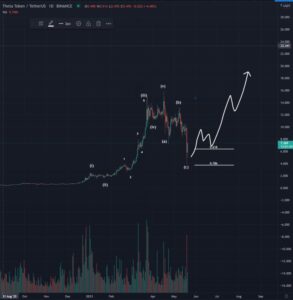The U.S Treasury Department is issuing a warning to investors that non-fungible tokens (NFTs) could be used to launder money.
In a new study, the agency says that the ability to transfer NFTs instantaneously across the world using the internet makes the nascent crypto sector a prime candidate for illicit activities.
“The emerging online art market may present new risks, depending on the structure and incentives of certain activity in this sector of the market (i.e., the purchase of non-fungible tokens).
The ability to transfer some NFTs via the internet without concern for geographic distance and across borders nearly instantaneously makes digital art susceptible to exploitation by those seeking to launder illicit proceeds of crime, because the movement of value can be accomplished without incurring potential financial, regulatory or investigative costs of physical shipment.”
The department finds that one popular method to launder money using NFTs is when one entity acts as both the buyer and seller of an asset during a transaction in order to create a record of sales for it on a blockchain.
The bad actors would then sell the asset to an unsuspecting buyer in order to receive clean funds, according to Treasury Department.
“NFTs can be used to conduct self-laundering, where criminals may purchase an NFT with illicit funds and proceed to transact with themselves to create records of sales on the blockchain. The NFT could then be sold to an unwitting individual who would compensate the criminal with clean funds not tied to a prior crime.”
The Treasury Department also says that another risk that comes with NFTs is that transactions offer a certain degree of anonymity.
“It is also possible to have direct peer-to-peer transactions of NFT-secured digital art without the involvement of an intermediary, and these transactions may or may not be recorded on a public ledger.
These digital art assets are inherently easier to transfer between transacting parties than traditional art because, in most cases, the parties do not need to physically move the art or pay for shipping services such as insurance, transport, or customs duties, although users may incur transaction fees.”
You can read the complete study here.
Check Price Action
Don’t Miss a Beat – Subscribe to get crypto email alerts delivered directly to your inbox
Follow us on Twitter, Facebook and Telegram
Surf The Daily Hodl Mix

Disclaimer: Opinions expressed at The Daily Hodl are not investment advice. Investors should do their due diligence before making any high-risk investments in Bitcoin, cryptocurrency or digital assets. Please be advised that your transfers and trades are at your own risk, and any loses you may incur are your responsibility. The Daily Hodl does not recommend the buying or selling of any cryptocurrencies or digital assets, nor is The Daily Hodl an investment advisor. Please note that The Daily Hodl participates in affiliate marketing.
Featured Image: Shutterstock/Tithi Luadthong/Natalia Siiatovskaia
- According
- across
- activities
- advice
- advisor
- Affiliate
- affiliate marketing
- Although
- android
- Anonymity
- Another
- app
- Art
- asset
- Assets
- Bitcoin
- blockchain
- Buying
- cases
- Costs
- could
- Crime
- Criminal
- Criminals
- crypto
- cryptocurrencies
- cryptocurrency
- customs
- digital
- Digital Art
- Digital Assets
- diligence
- distance
- during
- emerging
- financial
- finds
- funds
- high-risk
- HODL
- HTTPS
- image
- individual
- insurance
- Internet
- investment
- Investments
- Investors
- issues
- IT
- latest
- Latest News
- Ledger
- Making
- Market
- Marketing
- money
- Money Laundering
- most
- move
- movement
- news
- NFT
- NFTs
- non-fungible tokens
- offer
- online
- Opinions
- order
- Pay
- physical
- Popular
- present
- public
- purchase
- recommend
- record
- records
- regulatory
- Risk
- sales
- Samsung
- sector
- seeking
- sell
- Services
- Shipping
- sold
- Study
- The Daily Hodl
- the world
- Tied
- Tokens
- trades
- traditional
- transaction
- Transactions
- transport
- treasury
- Treasury Department
- u.s.
- us
- users
- value
- WHO
- without
- world
- would











